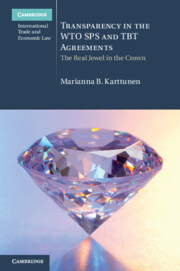Book contents
- Transparency in the WTO SPS and TBT Agreements
- Cambridge International Trade and Economic Law
- Transparency in the WTO SPS and TBT Agreements
- Copyright page
- Dedication
- Contents
- Figures
- Tables
- Foreword
- Acknowledgements
- Abbreviations
- Table of Cases
- Country Classification
- Introduction
- Part I Why the SPS and TBT Agreements?
- PART II Transparency as a Substitute for Dispute Settlement
- Part III Transparency as a Complement to Dispute Settlement
- 6 Transparency and Disputes
- 7 Climbing the WTO Disputing Pyramid
- 8 Access to the WTO Disputing Pyramid
- 9 Is the Current Interaction between Transparency and Dispute Settlement the Best It Can Be?
- Conclusion of Part III
- Conclusion
- Appendices
- References
- Index
Conclusion of Part III
from Part III - Transparency as a Complement to Dispute Settlement
Published online by Cambridge University Press: 28 April 2020
- Transparency in the WTO SPS and TBT Agreements
- Cambridge International Trade and Economic Law
- Transparency in the WTO SPS and TBT Agreements
- Copyright page
- Dedication
- Contents
- Figures
- Tables
- Foreword
- Acknowledgements
- Abbreviations
- Table of Cases
- Country Classification
- Introduction
- Part I Why the SPS and TBT Agreements?
- PART II Transparency as a Substitute for Dispute Settlement
- Part III Transparency as a Complement to Dispute Settlement
- 6 Transparency and Disputes
- 7 Climbing the WTO Disputing Pyramid
- 8 Access to the WTO Disputing Pyramid
- 9 Is the Current Interaction between Transparency and Dispute Settlement the Best It Can Be?
- Conclusion of Part III
- Conclusion
- Appendices
- References
- Index
Summary
As we have seen, only a very small fraction of specific trade concerns (STCs) eventually end up in formal disputes, arguably because the transparency framework has allowed Members to effectively manage conflicts at an informal level. The majority of all SPS and TBT disputes are discussed in the SPS and TBT Committees before, during or after the formal dispute is raised, and this is especially true of disputes that focus on SPS or TBT issues. Developing countries in particular tend to launch STCs before or in parallel to dispute settlement procedures, whereas the EU and the United States raise formal requests for consultations in the TBT Committee without first passing through Committee discussions. This confirms that WTO Members truly view the Committees as a valuable forum in which to work through disputes regarding domestic regulatory matters and, often, a privileged space with regard to costly formal dispute settlement procedures. The behaviour of the EU and United States confirms that they may have other means of managing trade conflicts or gaining information to build disputes that does not require them to raise STCs as systematically as other Members.
- Type
- Chapter
- Information
- Transparency in the WTO SPS and TBT AgreementsThe Real Jewel in the Crown, pp. 292 - 293Publisher: Cambridge University PressPrint publication year: 2020



